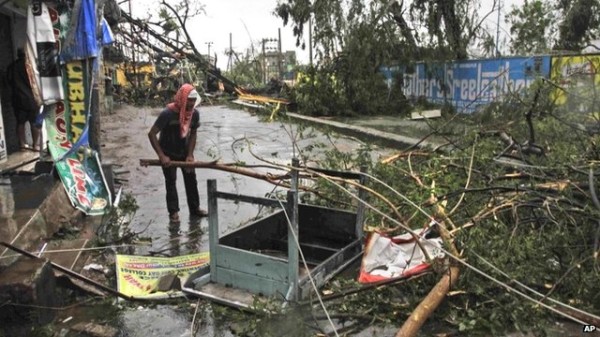
The BBC's Sanjoy Majumder: "We had a roof above us yesterday and that's gone"
Indian disaster teams have begun a relief operation after Cyclone Phailin crashed into eastern areas, forcing up to one million people to flee.
Officials are assessing the damage and providing food to hundreds of thousands who spent the night in shelters.
The cyclone wrecked many coastal homes, uprooted trees and blocked roads in Andhra Pradesh and Orissa states.
Five deaths have so far been linked to the cyclone, far fewer than were initially feared.
In 1999 a cyclone killed more than 10,000 people in Orissa.
But the authorities said they were better prepared this time.
The BBC’s Sanjoy Majumder in Berhampur, Orissa, says the authorities made massive effort to get the message out to people, many of whom were reluctant to leave their homes.
He says their efforts appear to have paid off.
The massive storm made landfall on Saturday, packing winds of up to 200km/h (125mph).
It was weakening on Sunday as it made its way north-west.
In Orissa’s state capital, Bhubaneswar, crews were using axes and rope to clear fallen trees from roads.
“We’ve just started to assess the damage and coastal areas will have fared worse,” said crew leader Upendra Malik.
The storm tore down power and communication lines and knocked out road and rail links, making an assessment difficult.
But officials were confident that a massive loss of life had been avoided.
“We were preparing for a super cyclone, but Phailin did not turn into a super cyclone,” disaster official Tripti Parule told the AFP news agency.
He said the evacuation was the biggest in India’s history for such an event.

Early on Sunday, Indians were clearing roads and assessing the damage done by Cyclone Phailin.

The storm forced hundreds of thousands to flee and spend the night in makeshift refuges.

Coastal areas in Orissa and Andhra Pradesh states were the hardest-hit regions.

The storm was the most powerful to hit the region since 1999, when more than 10,000 died.
The Times of India reported that a storm surge more than 3m (9ft) high had flooded areas of Ganjam, Khurda, Puri and Jagatsinghpur districts of Orissa and the Srikakulam district of Andhra Pradesh.
Many villages are still said to be surrounded by water.
The Indian Army’s National Disaster Response Force (NDRF) said 1,200 troops had been sent to Orissa and 500 to Andhra Pradesh.
“As soon as the fury of the cyclone abates our boys will start their work,” NDRF director general Krishna Chaudhary told reporters.
“The teams have medical first responders (for first aid) and heavy cutting equipment. In the case of cyclones there is a likelihood of collapsed buildings.”
Up to 25cm of rain is predicted for Orissa and the north coast of Andhra Pradesh throughout Sunday and Monday, forecasters said.
In the coastal town of Gopalpur, one of the worst-affected areas, hundreds of terrified residents spent the night huddled in shelters, schools and public buildings.
Witnesses reported seeing shards of glass and asbestos sheets flying through the air as the cyclone struck.
Shop signs and other debris were being pitched high in the air by storm gusts and elaborate decorations for a major Hindu festival were strewn over the main road.
Officials had earlier said that no-one would be allowed to stay in mud and thatched houses along the coast of Orissa and Andhra Pradesh states, but some residents said they wanted to stay put.
“Many people refused to move, had to be convinced, and at times the police had to forcefully move them to safe places,” said Home Minister Sushilkumar Shinde.




Leave a reply